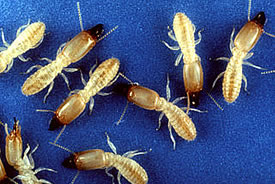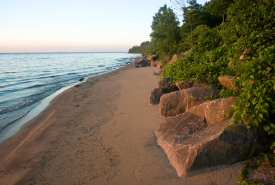The eastern subterranean termite: An introduced species in Ontario

Eastern subterranean termite (Photo by United States Department of Agriculture, Wikimedia Commons)
Most of us in Ontario, I think it is safe to say, don't give a moments thought to termites, or realize that they are found in this region. In fact you are unlikely to ever meet the acquaintance of one, unless your house unfortunately becomes infested or you set traps and search for them deliberately.
This summer I did just that: I set up termite traps in several pockets of Ontario where populations are known to occur. Through my research at the University of Western Ontario, I have sought to learn more about this cryptic yet fascinating insect species.
Similar to other insect species (ants, bees, wasps), termites live in structured societies that are generally divided into reproductive and non-reproductive caste members, each performing unique tasks. As far as is known, there is only one species of termite in Ontario — the eastern subterranean termite (Reticulitermes flavipes). Within the last century this species has been introduced to Ontario on at least three separate occasions from its native range in the eastern United States, likely through infested shipping cargo.
While this species plays an important role in consuming fallen woody debris within its native range, when displaced by human activity it is able to take advantage of urbanized dwellings and become a formidable pest on wooden structures. As these termites feed exclusively on wood, an older wooden home (particularly one with abundant moisture) provides all the resources a termite colony could want.
As they feed on the abundant wood available, the hollow tunnels the termites leave provide them with a source of shelter and moisture. The warmth of a heated home allows them to survive the harsh winters of Ontario. Within Ontario the worst reported areas of infestation include several older neighborhoods of Toronto and Scarborough, as well as pockets of Guelph, Elora, Fergus, Windsor and as far north as Kincardine.

Shore of the Middle Point Woods property, Pelee Island, Ontario (Photo by Sam Brinker, OMNR)
Interestingly, in Point Pelee National Park and Pelee Island, established populations of the eastern subterranean termite are found living along sandy shorelines. Until recently, very little was known about these populations, or even that they existed.
There were reports of a termite introduction on Point Pelee in 1929, but they were presumed extirpated until 2009, when professor Graham Thompson and his colleagues confirmed the presence of colonies along two major sections of beach. These colonies could have been descendants of the introduced population or could potentially be the only known location of native, free living termites in Ontario.
I had the pleasure of staying at Nature Conservancy Canada’s Ivey Research Station on Pelee Island this summer. An active colony is found right beside the station lodge. Interestingly these colonies have not infested the station or any other structures on the island. Despite an abundance of human activity and wooden structures, they prefer to feed on rotting driftwood or piles of firewood, as is found by the research station.
Because they dig underground tunnels and move frequently to different foraging sights, termites remain out of sight for most humans. As such, in order to study their behaviour it is best to locate and collect colonies through trapping. A termite trap is a simple device consisting of a corrugated cardboard roll and wooden plywood lid, buried one inch below the ground. These rolls provide an attractive source of shelter and food for termites.
The traps are collected withintwo to three weeks. It is always exciting to open the traps and find hundreds to thousands of foraging workers, soldiers and nymphs, which appear like small white ants.
Workers are the most numerous caste members, performing various helping behaviours for the colony. Soldiers have large yellow heads and mandibles used to defend the colony against intruders, and nymphs are the premature stages of various colony members. In the eastern subterranean termite, numerous nymphs called secondary nymphs reproduce in underground tunnels. They can contribute to colonies reaching enormous sizes, from hundreds of thousands to millions of related individuals.
With colonies that attain such large sizes, I am interested in learning more about what cues nestmates might be using to be able to recognize their related nestmates. Invasive colony populations may have lost some ability to recognize fellow nestmates, and unrelated colonies can merge to form expansive group sizes that are hard to eradicate.
For my project, I am interested in learning more about what kind of cues individuals might be using to recognize one another. Are they relying on genetic or environmental cues? Answering these questions will help shed further light on the biology of this interesting species.


